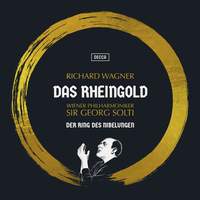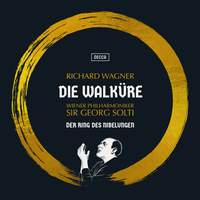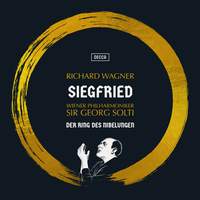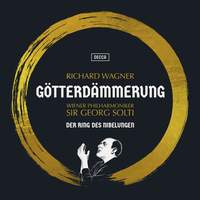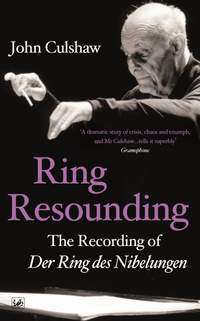Interview,
Dominic Fyfe and Philip Siney on remastering Solti's Ring Cycle
Earlier this year, I spent a wonderful afternoon over at Decca's London HQ with producer Dominic Fyfe and sound-engineer Philip Siney, who allowed me to compare and contrast the latest remastering of some key passages from The Ring (including the very opening of the cycle, the Ride of the Valkyries, Forest Murmurs and the Immolation Scene) with their earlier incarnations - and shared some fascinating insights into the stories they uncovered and the challenges they faced along the way...
The Solti Ring was famously described as 'the greatest recording of all time' by Gramophone - why was it such a game-changer when it was first released?
Dominic: This project has been a labour of love, because it has really lifted the lid on how Decca made recordings in that era. It’s fascinating to imagine how this must have sounded to people back in 1958, when recording opera in stereo was only a few years old. The only precedent for a complete studio recording of a Wagner opera was the beginning of the Furtwängler Ring on EMI, which was never finished: they recorded Die Walküre in 1954, and that was in mono. So the Solti Ring was the first time a complete Wagner opera was put down in this way: in stereo and conceived for the studio.
Philip: John Culshaw had been involved in the live recordings at Bayreuth in 1951 and 1953, and I think the experience gave him an aversion to trying to do anything live: stage-noise, the risk of problems in the performance…there were just too many compromises.
Bayreuth is presumably a pretty challenging acoustic in which to record?
Philip: With the orchestra basically in a wooden box – it’s an engineer’s nightmare!
Dominic: And all the seating is very steeply raked. It was during those Bayreuth performances that Culshaw began to conceive the idea of a studio recording of the Ring; they had a couple of trial runs: in 1956 they did the third act of Die Walküre with Solti, and a year later the first act with Knappertsbusch. Those were both in stereo and it gave them a chance to experiment, because they were recorded in the same venue that would be used for the complete cycle - the Sofiensaal in Vienna. But even so, they were heading into complete uncharted territory: it was the recording equivalent of Shackleton going to the South Pole!
What was the source-material like from a technical perspective?
Dominic: These are the original master-tapes that were transferred, and we also had some of the original microphones. (Just two types were used on the original recording, Neumann KM56s and M49s: one for singers and another for the orchestra). All we’ve had to work with are these two-track stereo mastertapes, so there’s no separation of orchestra from voices: we can’t unpick anything. But in a way that’s a good thing, because it means that the balance has been a constant throughout: it’s the one thing that the original team set and approved.
Were any of the original recording-team still on hand to consult whilst you were working on this remastering?
Dominic: Philip joined Decca in 1989 and was trained by Jimmy Lock, who was the last living link to the Ring sessions: he’d been present for the recording of Götterdämmerung, and did the 1984 and 1997 transfers. When Philip did the 2012 mastering for the Wagner bicentenary it involved revisiting Jimmy’s work, so there's some continuity of knowledge.
Philip: Another valuable source was Humphrey Burton’s documentary The Golden Ring, which was filmed during the sessions for Götterdämmerung in 1964 and broadcast the following year. Watching that gave us a lot of insight in terms of the microphones that they used, how they were rigged in the studio and so on. The British Library holds a lot of footage which didn’t make the final cut, so we’re trying to retrieve that…
Did you have access to Culshaw's session-notes?
Dominic: There are no session-notes – nothing at all! We do have Culshaw’s editing scores for three of the operas; just recently I got in touch with his nephew Nigel Black (former Principal Horn in the Philharmonia) who inherited a whole archive of scores, photographs and letters, so he may have the missing score…
The stage was marked up like a chessboard so that the singers could be moved around according to the stage-instructions: in that Burton film you see the assistant producer Christopher Raeburn literally pulling Birgit Nilsson back from the microphone as she attacks one of the high notes! All of that’s detailed in the score, so that Culshaw would be able to tell the balance-engineer which microphone needed to be on for which singer at any given moment. The incredible thing is that they had to do all of this in real time, including off-stage effects.

How much input did the singers have into the original editing process?
Dominic: A lot of the editing was done in situ, because they were based in Vienna for a fairly long time and the sessions were quite spaced out. They would invite the cast in to listen to playbacks once an act had been edited, but it probably wasn’t the kind of detailed approvals process that we have today - I suspect there was more of an element of trust in the team to assemble the right things.
Philip: There was also no real scope for experimentation: these days you can edit something in seconds and reverse it just as quickly if it doesn’t work, whereas back then it was all tape and razor-blades!
Dominic: They used very long takes, recording twenty-minute sections at a time, and it’s quite impressive just how few edits there were. Again, that’s very different from today: it’s quite rare to have such long stretches of music performed without any intervention. I’ve been at Decca for long enough to have worked with a generation of artists that would always record complete takes – the late Nelson Freire, for instance, would always deliver complete movements as far as possible. I think there was a different mentality around recording in that era: artists saw it as their job to deliver the finished article, rather than relying on us to fix things.
Did either of you ever work with Solti directly?
Philip: I worked with him in the last few years of his career, and he was a lovely chap - intensely serious and dedicated, but also very sociable. And because he lived fairly close to where the Decca studios were at the time, he’d phone up and say ‘I have a problem with my hi-fi! Come and sort it out, Philip!’.
Dominic: But he was quite old-school when it came to recordings: he was entirely in charge of balance and everything, and from what I know he never recorded bits here and there. His ideal was to go for a complete performance, and most of his later recordings were made live.
What was the Sofiensaal like as a recording-venue?
Dominic: The Sofiensaal was a box-within-a-box: there were surrounding halls where they could put off-stage effects like the steerhorns with a television-monitor, but it was all done in real time. The place was gutted by fire in 2001: most of the inside was completely destroyed, and it’s been converted into a hotel and offices. The hall itself has been reconstructed, but it’s no longer actually used as a venue.
Philip: It’s like an inner atrium, and the rooms of this very swish hotel look into the space where the Ring was recorded. We visited a couple of years ago, and it was quite useful to get a sense of the shape of the hall, especially when we came to create surround-sound. The idea was to recreate how it would’ve sounded if you’d been in an ideal seat.
How much background-noise did you have to contend with?
Philip: Because it was recorded in Vienna we had a lot of tram-noise, as well as car-hooters and cutlery from the canteen…Of course if you go back to the LP and that’s barely audible, because low frequencies just didn’t go down that far. One approach would have been to leave absolutely everything in, but our view was very much that anything that was a distraction from the music should go. We haven’t been completely forensic, though: if there’s a page-turn or something else that is part-and-parcel of music-making we’ve left it in. I keep promising Dominic that I’ll make him a tape of just the extraneous noises!
Dominic: You also hear Solti thumping about on the rostrum – in the film you can see that he was very physical, and it just wouldn't feel right to airbrush all of that out.
Philip: I did have to do that for the Atmos version, though, because the sub-woofer really accentuates the Solti Thumps!
Dominic: One of the funniest things cropped up in Die Walküre: I was listening to the edit which Philip had sent me and picked up the sound of a door shutting, which I was sure was a bit of studio-noise which they didn’t intend to be left in. I checked it against the 2012 version and it wasn’t there, but then I went to an SACD version which had been issued for the Japanese market in 2008 and it WAS there! That sent me back to Culshaw’s score, and underlined there in red is a stage-direction asking for a bolt to be drawn and a door closed: it was an intentional sound-effect!
What sort of new technology did you have at your disposal this time around?
Dominic: The main thing is that it’s a much higher resolution: the 1997 and 2012 versions were 48 kHz/24-bit, and we’ve upgraded to 192kHz. That gives you so much more frequency-response, especially at the top end – hearing the details and overtones emerge in the violins and brass is just like watching picture restoration.
The other thing that we’ve done (which is slightly unusual for Universal) is to go back to Hybrid SACD – very few people these days have an SACD player, but of course they also work in Blu-ray players. We felt that after going to all this trouble to have the highest resolution there was no point of putting it down to 16-bit 44.1, and the DSD layer of an SACD gives you that higher resolution. Even if you simply compare the 2012 CD with the 2022 CD layer of the hybrid disc, you’ll still hear the difference.
One of the most significant steps forward in the past decade has been the advances in noise-reduction software. The 2012 remastering used the existing 1997 transfer, which had already had noise-reduction applied to it; they’d used a process called CEDAR, which was the standard tool for trying to de-hiss earlier recordings at the beginning of the CD era, and it was pretty crude. Once it’s applied and played back you can’t undo it: although Philip was able to mitigate some of the worst effects, it would shave off and start numbing down the sound. Having a brand-new set of transfers without anything applied to it meant we could just start from scratch.
Philip: It's a bit like if you take a digital photograph and you have a raw file with no filters: we could use the most up-to-date de-hissing software, and there are sections of the music where you need it to be more applied than in others. The software now allows you to vary it absolutely according to need.
Dominic: The LPs were all mastered at Abbey Road at half-speed (there’s a little clip on YouTube about this process). Philip and I have listened to all fifteen hours of the Ring many times in the course of this project, but the person who deserves the biggest medal is Miles Showell at Abbey Road because he’s done it all at half-speed! There ought to be a Grammy Award for endurance…
Philip: Can you imagine 'Ride of the Valkyries' played at half-speed?! But when you’re working from an incredibly hi-res digital file and want to obtain as much of that dynamic range and frequency-response in a groove on a vinyl record, then half-speed mastering is the way to go.
One other problem I had was that certain parts of the tape had just worn out – because you have metal oxide stuck on a plastic backing, that oxide sheds every time you play the tape which creates all sorts of effects. One is a bobbling sound in the bass, which was particularly troublesome around the horn solo in Siegfried, and at the beginning of Das Rheingold because it’s so quiet and exposed. You can remove it, but it takes time: it’s a bit like Photoshopping out a mole!
Was the Solti cycle your own first encounter with the Ring Cycle?
Dominic: It was indeed: the Penguin Guide was my Bible as a teenager, and the choice was basically Solti or Karajan. The one thing which the reviewers dwelt on was the quality of the sound: I remember them describing the sound-effects and placing on the Solti set in some detail, whereas on the Karajan set no effort was really made to give the aural impression of the opera literally unfolding before your eyes.
A little later on I came across John Culshaw’s book Ring Resounding which goes into a lot more detail, so gradually I began to put together a picture of how they conceived it – it’s an extraordinary feeling when you finally have Culshaw’s score in front of you and it’s still reeking of cigarette-smoke! I remember Philip calling me up one day to tell me that he’d found a piece of cardboard that had been taped inside the back cover of the Walküre score to make a little sleeve, and when he opened it up he found was a letter to Christa Ludwig about her session-times! We also scanned for the booklet Christopher Raeburn’s session plan: it’s like a grid that tells you session-by-session who was needed and when. It must have been quite a feat to co-ordinate all of that without spreadsheets or iPhones!
Looking at that grid reminded me of the calibre of the casting: even the smaller roles were taken by singers who went on to achieve greatness, some of whom are still alive. Brigitte Fassbaender is the Waltraute in Die Walküre; Gwyneth Jones was the Wellgunde in Götterdämmerung, and said she’d love to hear the new remastering. It would be wonderful to get them all together for a playback so they can hear themselves across sixty years and hopefully reignite some memories.
Are there plans to give more of the landmark recordings in your archive this luxury treatment?
As a company we have a responsibility to keep pace with the technology that’s available to show these recordings in their best light; we’re doing the same thing with the Britten War Requiem, which will be released towards the end of the year, and there will be more to come…
George London (Wotan), Kirsten Flagstad (Fricka), Claire Watson (Freia), Set Svanholm (Loge), Waldemar Kmentt (Froh), Eberhard Wächter (Donner), Paul Kuen (Mime), Jean Madeira (Erda), Gustav Neidlinger (Alberich), Walter Kreppel (Fasolt), Kurt Böhme (Fafner)
Wiener Philharmoniker, Sir Georg Solti
Available Formats: 2 SACDs, MP3, FLAC, Hi-Res FLAC, Hi-Res+ FLAC
Birgit Nilsson (Brünnhilde), Hans Hotter (Wotan), Régine Crespin (Sieglinde), James King (Siegmund), Christa Ludwig (Fricka), Gottlob Frick (Hunding)
Wiener Philharmoniker, Sir Georg Solti
Available Formats: 4 SACDs, MP3, FLAC, Hi-Res FLAC, Hi-Res+ FLAC
Wolfgang Windgassen (Siegfried), Birgit Nilsson (Brünnhilde), Gerhard Stolze (Mime), Hans Hotter (Wanderer), Gustav Neidlinger (Alberich), Marga Höffgen (Erda), Kurt Böhme (Fafner), Dame Joan Sutherland (Waldvogel)
Wiener Philharmoniker, Sir Georg Solti
Available Formats: 4 SACDs, MP3, FLAC
Birgit Nilsson (Brünnhilde), Wolfgang Windgassen (Siegfried), Gottlob Frick (Hagen), Gustav Neidlinger (Alberich), Dietrich Fischer-Dieskau (Gunther), Claire Watson (Gutrune), Christa Ludwig (Waltraute)
Wiener Philharmoniker, Sir Georg Solti
Available Formats: 4 SACDs, MP3, FLAC, Hi-Res FLAC, Hi-Res+ FLAC
John Culshaw
Available Format: Book




